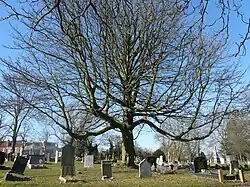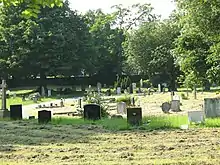Camberwell Cemeteries
The two Camberwell cemeteries are close to one another in Honor Oak, south London, England. Both have noteworthy burials and architecture,[1][2] and they are an important source of socioeconomic data in recording the historical growth and changing demography in the community for the Southwark area since 1855.[3]
| Camberwell Cemeteries | |
|---|---|
 Camberwell Old Cemetery | |
| Details | |
| Established | 1855 |
| Location | |
| Country | England |
| Type | Public |
| Owned by | Southwark London Borough Council |
| Size | 12 hectares (30 acres) Old Cemetery 27.6 hectares (68 acres) New Cemetery |
| Website | Old Cemetery New Cemetery |
| Find a Grave | 2180349 Old Cemetery 2249609 New Cemetery |
Camberwell Old Cemetery

.jpg.webp)
The old cemetery, located on Forest Hill Road, covers approximately 12 hectares (30 acres). It is part of the second wave of mid 19th century cemeteries[4][5] that were established in London to solve the problem of overcrowding in church yards.[6] The first wave of cemeteries are commonly known as the Magnificent Seven.
The site was purchased in 1855 by the Camberwell Cemetery Board (formed 1850) from the Trustees of Sir Walter St John's Charity at Battersea for £9,927.[3] It was originally meadow land, which was then designated as a Burial Ground of St Giles, Camberwell.[7]
The first interment took place on 3 July 1856; over 30,000 burials took place in the subsequent 30 years. In 1874 the cemetery was expanded by a further seven acres with the inclusion of land bought from the British Land Company for £4,550.[3] By 1984, 300,000 interments had been carried out at the cemetery.[8]
The Gothic Revival lodge and two chapels (one Church of England and one Non-Conformist) were designed by Sir George Gilbert Scott's architectural firm.[7][9] When burials were transferred to the New Cemetery the chapel fell into disrepair and both were demolished in the 1960s. A third (Roman Catholic) chapel was demolished in the 1970s.[10] Later the architectural importance of the lodge was recognised[11] and when it was destroyed by fire in the 1970s it was restored rather than being torn down. The lodge was used in the 1970 film adaptation of Joe Orton's play Entertaining Mr Sloane, as well as scenes filmed in the cemetery among the graves.
There are 288 Commonwealth service war graves from the First World War, 160 of whom are in a war graves plot in cemetery's north-east corner where there are two Screen Wall memorials, one listing those buried in the plot and the other those buried elsewhere in the cemetery whose graves could not be marked by headstones. There is also a group of special memorials to 14 casualties buried in the Second World War.[12]
There is also an unusual First World War memorial dedicated to 21 civilians who were killed in a Zeppelin raid on Camberwell in 1917.[13]
On 1 July and 21 July 1944 V1 flying bombs landed in the cemetery. The blasts caused damage to surrounding properties, but no casualties.[14]
On 3 November 2011 Azezur Khan (a.k.a. Ronnie), was shot dead following a funeral in the cemetery.[15] Police believe that Mr Khan was an innocent bystander.[16]
Notable graves in the Old Cemetery
- James John Berkeley, chief engineer of the Great Indian Peninsular Railway[17][18]
- Frederick John Horniman, founder of the Horniman Museum, died 1906[19]
- Able Seaman Albert Edward McKenzie VC in Zeebrugge Raid, died November 1918[20]
- Harry Quelch (1858-1913), journalist, early British Marxist and trade unionist.[21]
- Elizabeth Mary Anne Eagle Skinner (1875–1929), founder of the Mystical Church of the Comforter[22]
- William Stanlake VC in Battle of Inkerman, died 1904[23]
- Charles Waters founder of the International Bible Reading Association.[24]
- Jack Whicher, noted detective and founder member of the Detective Branch of the Metropolitan Police, died 1881
- Liam MacCarthy (1853–1928) a London-based Irish nationalist, businessman, and activist who is best known for having the Gaelic Athletic Association (GAA) Liam MacCarthy Cup for hurling named after him.
Camberwell New Cemetery


The cemetery is located on Brenchley Gardens about half a mile from the old cemetery. In the early 20th Century it was recognised that the original cemetery would be at capacity[8] in the near future. The land for the new cemetery was purchased in three lots in 1901:
- The central portion of 9.7 hectares (24 acres) was bought from Alfred Stevens, farmer and landowner of Peckham Rye for £11,305[3]
- The western portion, 13 hectares (32 acres), next to One Tree Hill was bought later in 1901 also from Alfred Stevens for £19,469[3]
- A final 4.9 hectares (12 acres), adjoining the Brockley footpath were bought from the Governors of Christ's Hospital for £6,325[3]
Following its acquisition much of the 27.6 hectares (68 acres) of land was rented out for other uses, including a golf club and a fireworks factory run by Joseph Wells.[3] Although much of the land was later used for interments there are large portions that remain unused for burials. Some of this land is now a recreation ground and there now is strong local opposition to this land being used for its original purpose of burials.[8]
In 1926 the first part of the land was laid out as a cemetery and was consecrated by the Right Reverend William Woodcock Hough, Bishop of Woolwich. The first interment took place on 23 May 1927. A smaller section was set aside for use of Free Churches.[3]
The lodge, waiting room and mortuary chapels were designed by Sir Aston Webb and his son, Maurice.[25] Maurice Webb was the architect for the Honor Oak crematorium, built in 1939 to meet a growing demand for cremations. It is situated in the cemetery grounds, ten acres of which were landscaped as memorial gardens. The crematorium is also a listed building[26] and is notable for its beautiful stained glass window.[27] By 1984 over 91,000 cremations had been conducted.[3]
In addition to one grave from the First World War, there are 198 Commonwealth service war graves of the Second, some 80 of the latter in war graves plot in Squares 91 and 92. A Screen Wall memorial lists some 120 whose graves could not be marked by headstones, and 56 other service personnel who were cremated at the crematorium.[28]
The cemetery has recently been used as a filming location for London Boulevard and Hereafter[29]
Notable graves in the New Cemetery
- George Cornell East end gangster famously shot by the Kray twins in 1966 at The Blind Beggar public house
- General Frederick Coutts (1899–1986), Salvation Army general
- General Wilfred Kitching (1893–1977), Salvation Army general
- Freddie Mills world light heavyweight boxing champion from 1948 to 1950
- William Pullum world weight-lifting champion[30][31]
- John Trunley (1898–1944) a local celebrity who appeared on stage with Fred Karno in the early 20th century as a "fat boy" (he weighted 33 stone at age 18)[32]
- Anne Shelton (1923–1994) popular singer, the 'Forces' Favourite' in WWII[33]
References
- London Cemeteries: An Illustrated Guide and Gazetteer, Mellor and Parsons, 4th edition 2008
- Camberwell Old Cemetery London's forgotten Valhalla, R Woollacott, 2000
- UK Parliament, Memorandum by Southwark Regeneration (CEM 77), 2000
- "Genealogical Research, England and Wales, Victorian London Cemeteries". Archived from the original on 23 September 2011. Retrieved 11 August 2011.
- London's Victorian Garden Cemeteries, Catherine Richards, Time Travel Britain
- Victorian London – Death and dying – Overcrowding, The Victorian Dictionary, compiled by Lee Jackson
- "Southwark Council, Cemeteries, Camberwell Old Cemetery". Archived from the original on 28 September 2011. Retrieved 29 July 2011.
- Save Honor Oak Recreation Park,The Forest Hill Society.com
- "Architecture in Cemeteries, Ancestry Aid, Mary C". Archived from the original on 28 March 2012. Retrieved 29 July 2011.
- London Cemeteries: An Illustrated Guide and Gazetteeer by Hugh Meller & Brian Parsons
- Lodge to Old Camberwell Cemetery, British Listed Buildings
- CWGC Cemetery report.
- Historic England. "Monument to Members of Public Killed by Zeppelin, Camberwell Old Cemetery (1385532)". National Heritage List for England. Retrieved 5 December 2018.
- Flying Bombs and Rockets, V1 & V2 Logs SE21 & 22 Dulwich, Camberwell Old Cemetery, 02/07/44
- Metropolitan Police, News Item Accessed 10/11/11
- BBC News 10/11/11
- "Eminent Railwaymen of Yesteryear", James J. Berkeley, Indian Railway Fan Club, R.R.Bhandari, July 2008
- James John Berkeley, FIBIS Wiki, January 2019
- "Horniman, Frederick John – Horniman Museum & Garden's website". Archived from the original on 9 January 2014. Retrieved 9 January 2014.
- "Albert Edward McKenzie, Grave locations for holders of the Victoria Cross, South East London". Archived from the original on 28 October 2004. Retrieved 29 July 2011.
- Ernest Belfort Bax, "Introduction" to Harry Quelch: Literary Remains. E. B. Bax, editor. London: Grant Richards, 1914. Transcribed by Ted Crawford for Marxists Internet Archive. Retrieved 2 September 2009.
- The Mystical Church of the Comforter, Denmark Hill Railway Station
- "William Stanlake, Grave locations for holders of the Victoria Cross, South East London". Archived from the original on 28 October 2004. Retrieved 29 July 2011.
- Historic England. "Monument to Charles Waters, Camberwell Old Cemetery (1385530)". National Heritage List for England. Retrieved 28 April 2023.
- Lodge, Camberwell New Cemetery, British Listed Buildings
- Cremetorium, Camberwell New Cemetery, British Listed Buildings
- Honor Oak Park, Get Walking
- CWGC Cemetery report.
- Film London, Guide to filming in London, November 2010, Camberwell New Cemetery
- Super Strength Books, William A Pullum: Wizard of the Weight-Lifting World
- William A. Pullum, The Underground, Mixed Martial Arts, Ross Enamait
- London Cemeteries: An Illustrated Guide and Gazetteer, by Hugh Meller & Brian Parsons
- London Gardens Online: Camberwell New Cemetery
External links
- Aerial view from 1939, Camberwell New Cemetery from the English Heritage "Britain from Above" archive
